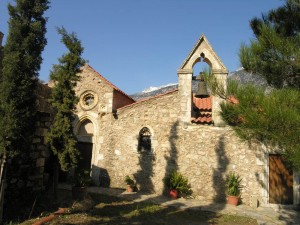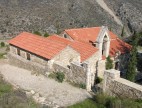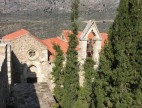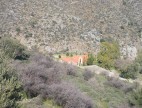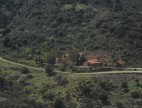Holy Monastery of Valsamonero
Even though the exact date of the foundation of the monastery is unknown, it may have been constructed in the 14th century, the same date as the original church, which today is the aisle of the All-Holy Virgin. The abbot, Jonas Palamas, was a leading figure of the monastery in the early 15th century, who played a key role in the establishment and the diffusion of the cult of St. Fanourios on Crete, the main centre of which was the Monastery of Valsamonero. It has been suggested, in fact, that the first icons of the saint that were created by the great painter of Chandakas, Angelos Akotantos, for the altar screen of the aisle of St. Fanourios in the Monastery of Valsamonero and which are now located in the monastery of Vrontisi were the result of collaboration between the abbot and the painter. Only the catholicon survives today, since the monastery was abandoned already from the 18th century and it constitutes a dependency of the Monastery of Vrontisi. The catholicon reached its present form after consecutive additions when the south aisle of St. John the Forerunner, the transverse one of St. Fanourios and the narthex on the west side was added to the original church of the All-Holy Virgin, the present north aisle. The decoration of these sections of the church was executed progressively from the middle of the 14th century, date of the wall paintings in the aisle of the All-Holy Virgin, to the middle of the 15th century, when the addition and wall decoration of the narthex was concluded. Of the 120 representations on the lateral walls, which are distinguished for their high quality, mention must be made of the only extant scenes known today from the life of St. Fanourios, in the aisle dedicated to him, which was founded by Jonas Palamas, and were written in 1431 by the painter Konstantinos Eirikos. The main body of the church in the aisle of the All-Holy Virgin, dated to the middle of the 14th century, presents a divergence from the established iconographic programme with the 24 leading Stanzas of the Akathist Hymn in its barrel-vault replacing the usual Gospel scenes, as is also observed moreover in other catholicons of monasteries dedicated to the All-Holy Virgin. Also characteristic is the rare depiction of the burial of St. Mary of Egypt, in which the lion digs her grave with its claws, urged by Abba Zosimas. Only a few representations, such as the monumental depiction of the Dormition on the northern wall, belong to a later layer, probably of the 15th century. The rebuilding and wall painting decoration of the sanctuary also date to the same period, in which a few Gospel scenes have been painted due to the limited space. A similar divergence from the usual iconographic programme is encountered in the aisle of St. John which was decorated in the years 1407–1428. The sanctuary was painted in 1407, featuring the bust of the Forerunner on the conch of the apse and Gospel scenes on the remaining surfaces while, in 1428, in the main body of the church, the most complete cycle of the life of the saint in 20 scenes was developed. In the narthex, that was built after 1431, when the walls of the aisle of St. Fanourios were decorated, some noteworthy, if very faded, scenes are developed. On the north wall, a multi-person Crucifixion with western influences, the Vision of Peter of Alexandria and the First Ecumenical Council are depicted, while the Dormition of St. John Chrysostom, the rare depiction of the transportation of an icon by Theodore the Stoudite via boat and the Elevation of the Holy Cross are on the barrel-vault.

